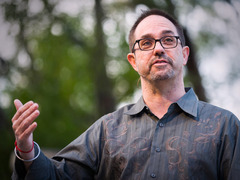 At TEDActive 2011, JD Schramm shares the story of his friend, John, who, after surviving a suicide attempt,
At TEDActive 2011, JD Schramm shares the story of his friend, John, who, after surviving a suicide attempt,
 JD Schramm: Break the silence for suicide attempt survivors
found that there were few resources available for someone in his position to be able to communicate the hardship he experienced and the depression he continued to battle. And there are others in this position, too – as Schramm points out, 19 out of 20 people who attempt suicide live but feel extreme isolation from others. This can lead to second, sometimes successful, attempt.
JD Schramm: Break the silence for suicide attempt survivors
found that there were few resources available for someone in his position to be able to communicate the hardship he experienced and the depression he continued to battle. And there are others in this position, too – as Schramm points out, 19 out of 20 people who attempt suicide live but feel extreme isolation from others. This can lead to second, sometimes successful, attempt.
This week’s TED Weekends on the Huffington Post emphasizes the importance of having an honest conversation about the taboo of suicide in order to help people in this at-risk situation. Below, find open and thoughtful essays on the subject.
JD Schramm: Revealing a Heartbreaking Secret on the TED Stage
My sharing of John’s story was my first attempt to spark a conversation about the taboo subject of suicide, and in particular the challenge of coming back from an attempt and choosing life. It worked well enough to bring more than a half million viewers to see it. It’s been lovingly translated into 39 languages by volunteers and shown at numerous TEDx events around the world. I said in the talk that I was trying to “start a conversation worth having about an idea worth spreading.” That idea is determining how best to support the many people who attempt suicide but fail and seek to return to life.
What I’ve learned since the privilege of delivering this talk and then having TED put it online has been profound. Read the full essay »
Lea Lane: What I’ve Learned from My Best Friend’s Suicide
Sometimes, especially when a person seems to have a satisfying life, we dismiss suicidal signals that would otherwise alert us. I know this first-hand.
Delia had a loving husband, two adorable and adoring young daughters, an 18th-century farmhouse filled with antiques. She was smart, kind, beautiful, active in the community and was revered in our Westchester County village, north of New York City.
When I moved to a nearby house with my first husband and two young sons, she came over with a bouquet of garden flowers to welcome us. I was charmed by her grace and warmth, and we soon became best friends. Read the full essay »
Mary Robin Craig: Faith-filled responses to suicide
During one of those interminable sleepless nights that followed the death of my oldest son, I crept downstairs in the dark and logged on to the computer to explore the views of the Christian Church on suicide. I was a midlife seminary student but, like most people, my knowledge of religious attitudes toward suicide was limited. I knew that suicide had been condemned by the early church and that those who died of suicide were once understood to be sinners of the worst sort, headed straight for hell. I knew that churches had at some point come to recognize that mental illness may reduce a person’s capacity to make decisions and, therefore, his or her responsibility for a self-inflicted death. My hours on the computer that terrible night revealed little beyond that basic information.
Five years have passed and I have learned a great deal more about the attitudes of both the general public and the clergy toward suicide. I now realize that our family benefited tremendously from knowledgeable attitudes toward mental illness and from the generosity of religious authorities. Read the full essay »
Comments (7)
Pingback: Real Kalpa Pharma Gear for Sale
Pingback: TED Talk: Break the Silence for Suicide Attempt Survivors
Pingback: Memorial Day | Military | Suicide | Please, talk | Transformed By Hope